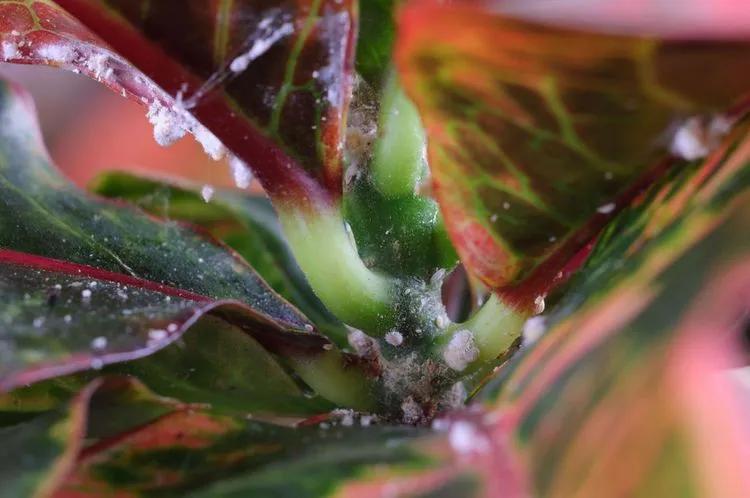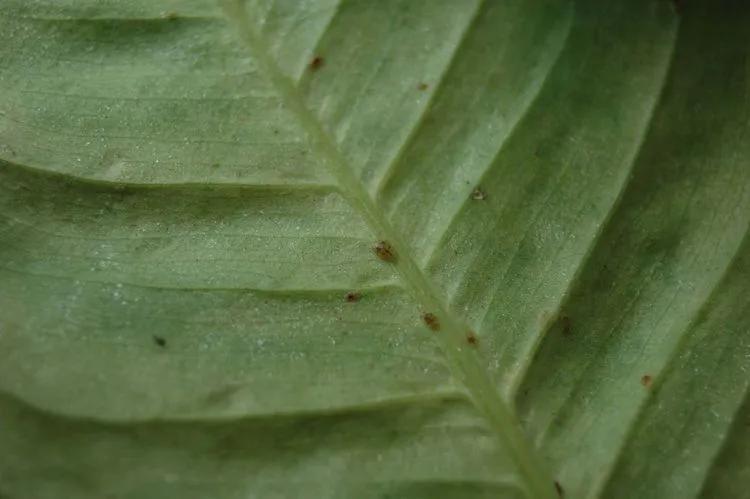Indoor insects are extremely challenging to exterminate, or if you manage to, a dramatic comeback is always expected, leaving plants seemingly no chance of getting spared.
However, before you give up and toss that bugged leafy ornament in the bin, we will explore the innate relationship between plants and insects in this blog. Get to know some of the most common bugs, their characteristic appearance, and treatments because “knowing your enemy,” a famous line said by Sun Tzu, is vital in winning the battle — a battle on how to get rid of bugs in houseplants. We also listed a few home remedies for bugs on plants to keep them off.

Do Indoor Plants Attract Bugs?
Yes, they do! The pests are lured by the plant's fragrant, sugary leaves — a perfect food source necessary for their survival and reproduction. When a recently purchased houseplant is placed indoors, it also comes with a free insect larva or eggs that will stay undetected until a few weeks. With the absence of extreme events–abrupt temperature swings, blazing solar radiation, fierce natural predators, and parasitoids–the ambient conditions offered by our cozy homes allow them to colonize the helpless plant successfully. Before damage becomes apparent, your ornamental plant has already been infested and slowly weakened by the pest.
List of Common Houseplant Bugs
With our 2-year experience in handling pest cases, we listed the most common insects below, their characteristics, and with special tips on how to keep bugs off plants:
1. Mealybugs. Mealybugs are soft-bodied, fluffy insects often mistaken as fungus for their white cottony appearance. They undetectably feed by sucking the sugary plant sap virtually in all plant parts: leaf undersides, plant crevices, and even soil, an essential biological adaptation to escape threats. Their waxy coating, which resembles a mold, protects them from drying out and penetrating pesticides.
Treatment: Dislodging with pressurized water, alcohol treatment, spraying with a water-oil emulsion, and replacing the top layer of the soil are recommended to knock off these tiny white bugs on houseplants. Systemic insecticides that work as stomach poison are the most effective insecticides, such as Aktara insecticide (spray with a solution of 4g / 5L and shed the soil with a solution of 1g / 10L, 4 times, interval 7-10 days) and contiguous auxiliary treatments (after 1-2 days) with Akarin, Agravertin, Iskra-bio, Karate, Inta-vir, Fitoverm (spraying with 1% solution, 4 times with an interval of 7-10 days).

2. Scale insects. Scales are close relatives of mealybugs with the same plant sap-siphoning habit. Shielded by their tough armored cover, these pests on indoor plants are challenging to control with pesticide spraying. In addition, even if they die, they are still glued to the surface, needing physical intervention to remove them.
Treatment: Remove the scales with a fingernail. Leaf tissues under the scabbard are often discolored. Wiping with an alcohol- or soapy water-dampened cloth also physically helps to dislodge the insect. Because waxy shields on their body protect them from the effects of contact insecticides, therefore, systemic insecticides of intestinal action are the most effective. Take the infested plant outdoors, and use Flupyradifurone or Acetamiprid according to the brand's instructions to combat scale insects.

3. Spider mites. Approximately 1mm long, spider mites are one of the species of indoor plant mites you don't want in your houseplants. These 8-legged creatures feed on the superficial cells and often crawl on the leaves' underside to protect themselves from the light. A network of woven webs is usually wrapped on the stems and leaves, which protects them if they colonize the plant.
Treatment: Remove the webs that are strangling the plant. Spray the leaf undersides and the plant crevices with cold or soapy water. For severely infested houseplants, take them to the shower and blast them with pressurized water to dislodge and drown the insects. Using indoor-safe acaricides, including Vertimek or Fitoverm, warrants control–applied at least three treatments are required at + 20 C after 10 days or at + 30 C after 3-4 days. Akarin, Agravertin, and Neoron will also help (4-fold treatments with an interval of 7-10 days).

4. Fungus gnats. Fungus gnats are relatives of fruit flies that emerge from wet, infested soil. They are harmless bugs in plant soil considered a house nuisance as they gather near the windowsills, resembling indoor plant flies. But, the larval forms, feeding in the soil debris, can sometimes injure the delicate young roots.
Treatment: The tiny bugs in houseplant soil emerge with high humidity. Therefore, it is crucial to keep the earth dry or allow it to dry in between waterings. Layering 5 cm-thick sand or diatomaceous earth and drenching all-purpose, general insecticides (indoor-safe pyrethrum or neem oil) into the pot prevents larval emergence. Drenching Bacillus thuringiensis subs. israelensis (Gnatrol), a bacterial spore suspension, kills the juveniles. vFor adults, setting sticky traps prevents them from flying.

5. Aphids. Aphids are little black bugs on plants that thrive in the most tender part of the plants–in the young shoots. Like its related bug cousins, they are gifted with a slender tube to pierce through the leaf cells and suck the juicy plant sap. Various species of aphids exist in different colors, such as green, black, orange, or yellow.
Treatment: They are easily purged with repeated, weekly treatments of a strong jet of water hose outdoors or in the shower. If ineffective, apply 1-2 treatments with Aktara (spraying at a concentration of 4g / 5L and watering at a concentration of 1 g / 10L), Akarin, Agravertin, or Iskra-bio (spraying with 5-8 ml / L), or another insecticide according to the instructions. Immediate effects may not be evident after several hours. All plants in the house should be treated as the aphids move quickly.

6. Thrips. Thrips are minute, slender, and elongated flying insects no different from other houseplant bugs. Their primary damage is by devouring the epidermal cells, leaving silvery, transparent patches on the surface. As the epidermal cells are stripped off, heavily infested leaves tend to curl down and eventually fall off.
Treatment: Hang sticky yellow or blue traps next to the infested plants. Making the leaves constantly wet by weekly showering prevents pest resurgence. When using insecticides against thrips, select the systemic ones that are more effective than a contact bug spray for indoor plants. For example, use Aktara insecticide (spray with a solution of 4 g / 5 l and spill the soil with a solution of 1 g / 10 l, 4 times, interval 7-10 days) and contiguous auxiliary treatments with Akarin, Agravertin, Iskra-bio, Inta-vir, Fitoverm (spraying with 1% solution, 4 times with an interval of 7-10 days, Inta-vir 8 g / 10 L).

How to Prevent Bugs on Indoor Plants
As prevention is better than cure, a cliche statement when treating an illness, we listed tips on how to prevent bugs on indoor plants:
- Monitor the leaves. Before purchasing a new plant, inspect it for any inconspicuous insects or bug eggs on leaves, typically underneath the leaves, the young shoots, or the plant crevices (leaf sheaths, petioles). Once they pass the visual inspection, constantly monitor them at home to spot insects early before causing a heavy infestation.
- Quarantine new and infested plants. After passing the health check in the nursery, isolate your plant for 2-4 weeks before introducing them indoors if you have other plants. In this manner, it can be treated outdoors before causing epidemics on susceptible houseplants. Likewise, if a bug is detected in a houseplant, quarantine it from others.
- Expose the plants to sunshine. If plants can handle full sunlight, introducing them to solar radiation reduces the bug's chances of reproducing. For example, spider mites are UV-sensitive, while mealybugs don't like direct heat.
- Purchase plants from nurseries. Nurseries have strict protocols in the fight against destructive arthropods. Although some bugs can escape even with harsh control measures, it is safe to say that buying plants from accredited plant centers is pest-free.
- Avoid over-fertilization. It is vital to keep the plants healthy with regular, light fertilization to strengthen their immunity against bugs on indoor plants. However, do not over-apply nitrogen, which will make the plant tissue softer and tender, which insects prefer.

Home Remedies for Bugs on Plants
The best alternatives are often found right in your house. Learn how to get rid of bugs on indoor plants with the following home remedies:
- Water. Water is all you need to get rid of bugs. Moisten the leaves daily with water and become uninhabitable for these hydrophobic bugs. Use a pressurized garden hose or shower to dislodge the insects for plants with a terrible plague.
- Soap. Insects are naturally covered with waxy cuticles to repel water. The addition of soap in water reduces the surface tension, making it stick better to the insect’s body and consequently drown them.
- Alcohol. Alcohol is a well-known sanitary liquid always available in your first aid box with insect-killing properties. Use any alcohol as long as it is diluted to about 5%. But, the safest and cheapest one is isopropyl or the common antiseptic alcohol. Pour the liquid into a cloth or cotton swab and wipe it on the tiny bugs on plants.
- Garlic and pepper spray. Blend in a head of garlic in 4 cups of water until smooth. Pour it into a 4-liter container and fill it with water until the brim. Store it in a dark room to ferment. After this step, strain the liquid and transfer it to spray bottles, ready to be used as houseplant insecticide. For added strength, add chili pepper or jalapeno infusion (15 minutes boiling) to the liquid. It can be sprayed on the bugs directly or into the soil to control fungus gnats. This will emit a powerful smell, so it would be best to do the treatment outdoors.
- Banana peel trap. Fungus gnats are attracted to volatile chemicals released by decomposing substrates. To take advantage of their vulnerability, place a banana peel inside a plastic bottle with holes enough for the flies to enter. Add apple cider vinegar or soapy water to break the surface tension and drown them as they attempt to rest on the trap.
- Neem oil. Neem oil is an essential plant oil extracted from a neem tree with a naturally insect-repelling and killing organic compound (azadirachtin). Commercial forms are available for spraying, while some need to be emulsified if you get a pure, cold-pressed oil. The pure form must be mixed with a few drops of soap and water before being used as houseplant bug spray.
- Pyrethrum. Like neem oil, pyrethrum is an insect-fighting compound derived from chrysanthemums. Pyrethrins, a synthetic version, also exist. Typically, this pesticide for indoor plants is readily available for spray; therefore, we recommend applying it according to the brand’s instructions.
- Aromatic plants. Some plants are gifted with naturally existing volatile compounds that deter pests, and planting them with susceptible plants keeps the bugs at bay. Mint, basil, rosemary, and oregano are examples of herbs to accompany your houseplants.
FAQ
When Should I Choose Chemical or Organic Pest Control?
Choose organic pest control for mild infestations or when treating indoor plants, as it’s safer for people, pets, and the environment. Chemical options are better for severe or stubborn pest problems when natural methods don’t work. Always use chemicals carefully and follow the instructions to keep your plants and space safe.
